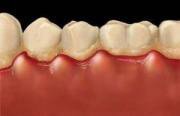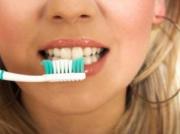Dental Plaque
 Plaque is the sticky, colorless film of bacteria that forms on teeth. It makes teeth “feel fuzzy” to the tongue and is most noticeable when teeth are not brushed.
Plaque is the sticky, colorless film of bacteria that forms on teeth. It makes teeth “feel fuzzy” to the tongue and is most noticeable when teeth are not brushed.
What Causes Plaque and Why Is It Harmful?
Plaque develops when foods containing carbohydrates (sugars and starches) such as milk, soft drinks, raisins, cakes, or candy are frequently left on the teeth. Bacteria that live in the mouth thrive on these foods, producing acids as a result. Over a period of time, these acids destroy tooth enamel, resulting in tooth decay. Plaque can also develop on the tooth roots under the gum and cause breakdown of the bone supporting the tooth.
How Can Plaque Formation Be Prevented?
- To prevent plaque buildup, brush your teeth at least twice a day with a soft, rounded-tip bristled toothbrush. Pay particular attention to the space where the gums and teeth meet. Use a fluoride-containing toothpaste.
- Floss between teeth at least once a day to remove food particles and bacteria.
- See your dentist or oral hygienist every 6 months for a check-up and teeth cleaning.
- Ask your dentist if a dental sealant is appropriate for you. Dental sealants are a thin, plastic coating that are painted on the chewing surfaces of teeth to protect them from cavities and decay.
- Eat a balanced diet and limit the number of between-meal snacks. If you need a snack, choose nutritious foods such as plain yogurt, cheese, fruit, or raw vegetables. Vegetables, such as celery, help remove food and help saliva neutralize plaque-causing acids.
 Self-Examination for Dental Plaque
Self-Examination for Dental Plaque
A self-examination for dental plaque is done using a product that stains the plaque on your teeth. Dental plaque is a sticky film of bacteria that sticks to your teeth, the spaces between the teeth, and under your gums. It can harden into tartar. The stain lets you to see how well you are brushing and flossing your teeth.
Plaque is made of different germs (bacteria) that grow on teeth. These bacteria react with sugars and starches in foods to make acids and other substances that can cause problems and damage the teeth, gums, and bone. Acids can eat away at tooth enamel by removing minerals from the enamel (this is called demineralization).
Products you can use at home include:
- Disclosing tablets
- Disclosing solution.
- Disclosing swabs.
These products stain plaque that was missed when you brushed and flossed along your gum lines and between your teeth. Good brushing and flossing breaks up the plaque and does not let the bacteria and acid cause problems.
